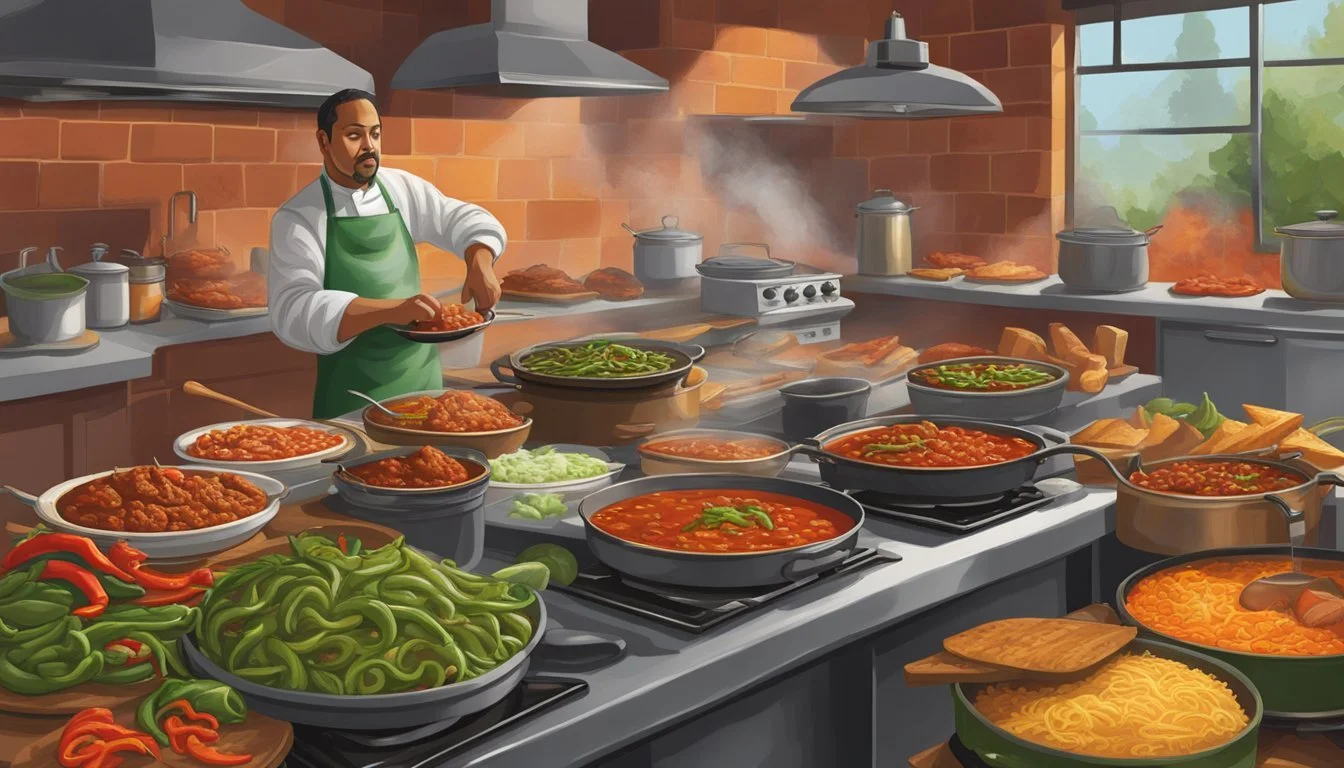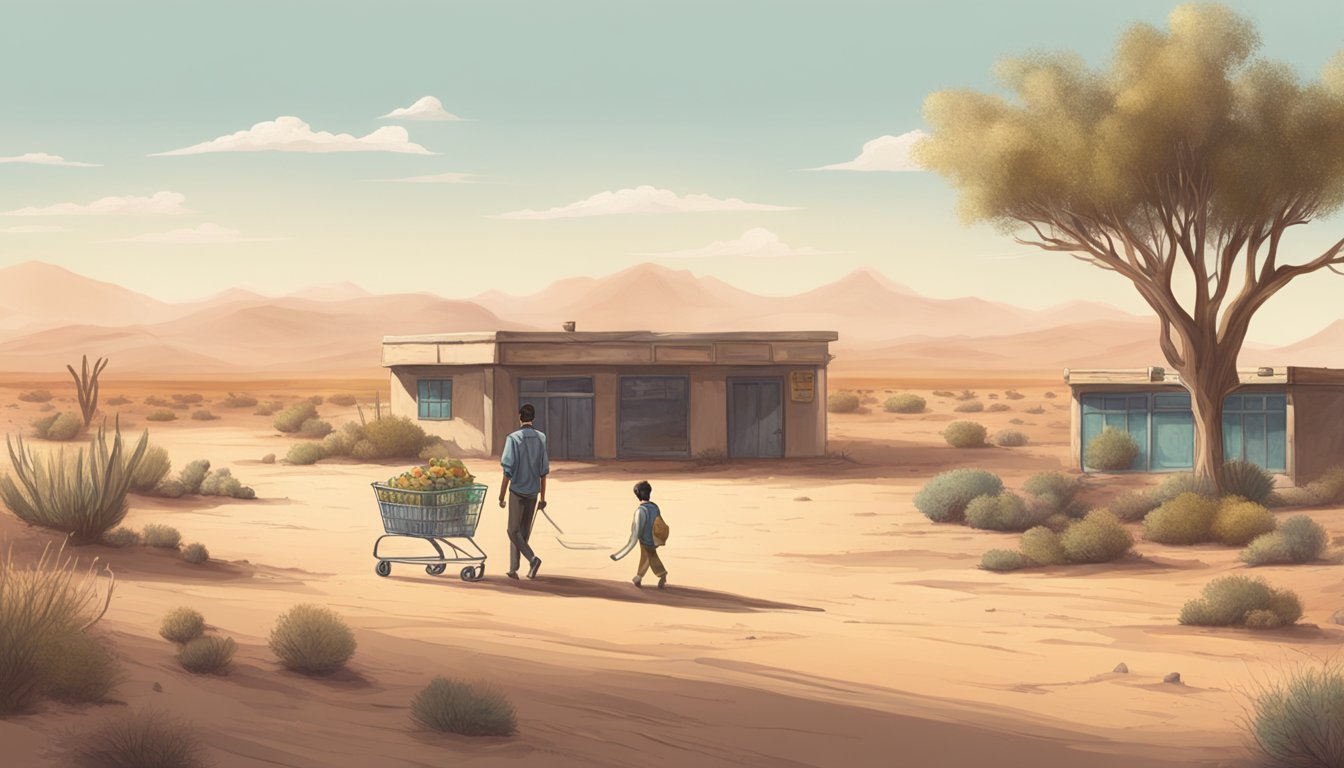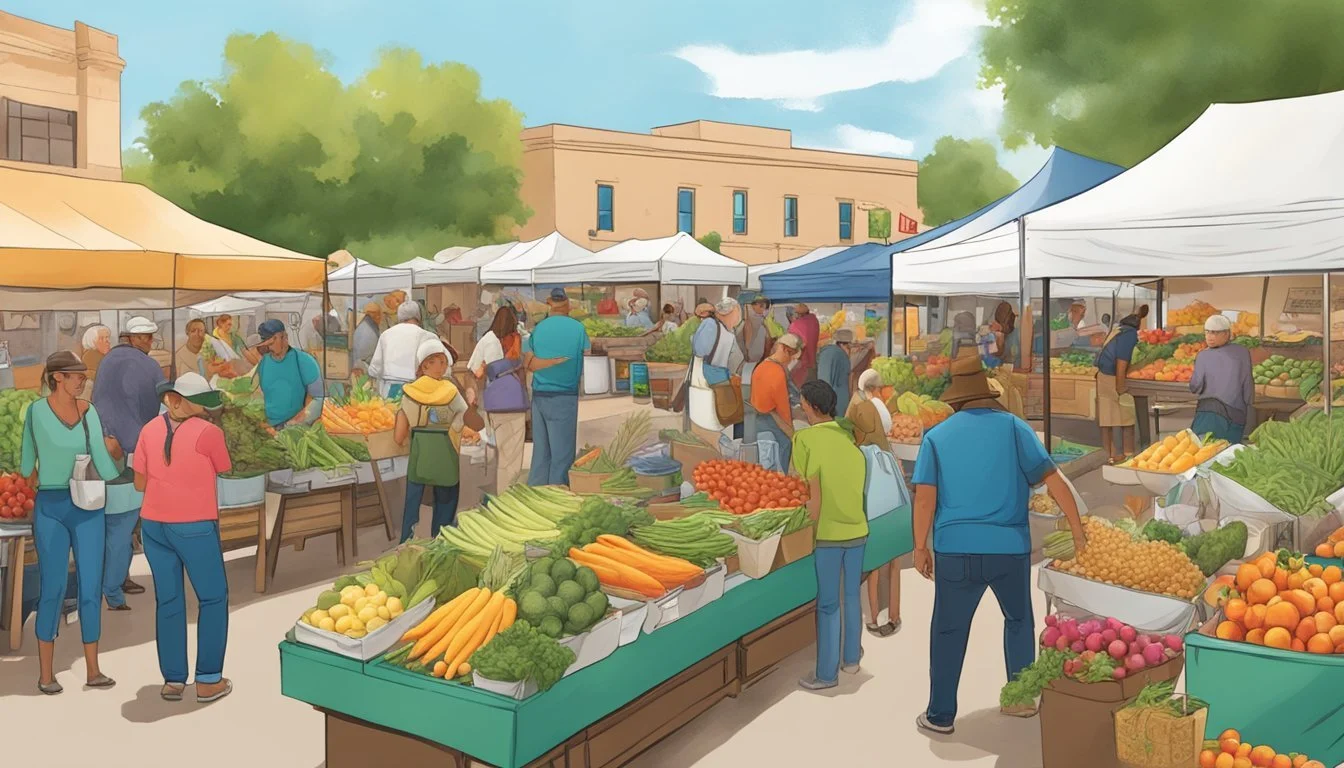New Mexico Food Challenges
Ultimate Guide to Spicy Eats and Epic Portions
In New Mexico, food challenges offer both local and visiting gastronomes an opportunity to test their culinary limits. These eating contests vary from restaurant to restaurant, each with its unique set of rules and rewards. They are not only a test of one's appetite but also a way to engage with the local food culture and its larger-than-life portions. From massive burritos to fiery hot dishes, these challenges draw in those seeking to capture a victory, often in the form of a free meal or even restaurant merch.
An interesting component of these challenges is their potential to turn a meal into an event that draws a crowd. Establishments like Cecilia's Café in Albuquerque have capitalized on this by offering a 10-pound burrito challenge which, if completed within the set time limit, rewards the victor with both free food and exclusive attire. Challenges like these underscore the playful side of dining and community engagement, prompting stories that both locals and tourists can share about their New Mexico experience.
Overview of New Mexico Food Challenges
In New Mexico, the challenge of food insecurity has been a long-standing issue, which has been further exacerbated by the COVID-19 pandemic. Data indicates that both urban and rural areas of the state have faced significant difficulties in ensuring consistent access to nutritious food for their populations.
Rural Areas: In these regions, where populations often do not exceed 20,000 individuals, the distance from food retailers and limited transportation options compound the problem.
Urban and Metro Areas: While these places, with populations ranging from 20,000 to 99,000 in urban, and over 100,000 in metro areas, might have better infrastructure, economic disparities and job losses during the pandemic critically impacted food security.
Mexico shares a border with New Mexico, which influences the state's agricultural and food distribution systems. Various studies and surveys conducted in 2020 provide a snapshot of the concerning situation. The challenges include not only the physical availability of food but also the affordability, influenced by factors such as income levels and employment status.
On the policy front, initiatives aimed at alleviating these issues were seen taking shape with input from citizens and organizations. Over 250 New Mexicans have collaborated on various projects to improve food systems, indicating a strong community response to these challenges.
It is evident that multiple factors contribute to the food insecurity scenario in New Mexico, and these have been highlighted during the health crisis brought on by the pandemic. Local councils and associations have recognized these challenges, as seen in their responses and the creation of support mechanisms for vulnerable populations.
Impact of COVID-19 on Food Security
The COVID-19 pandemic significantly disrupted food security in New Mexico, affecting food access for individuals and challenging the agriculture and supply chain sectors.
Pandemic's Role in Food Access
The advent of the coronavirus pandemic led to increased levels of food insecurity in New Mexico, with certain groups experiencing disproportionate effects. Prior to the pandemic, New Mexico already had concerns regarding food access, but these were greatly exacerbated by the crisis. Studies indicate that in 2019, approximately 24.1% of children were at risk of hunger, and projections for 2020 showed an overall increase in food insecurity to 20.7% following the pandemic's onset. These figures highlight the urgent need for continued efforts to mitigate food access issues as New Mexico navigates the lingering effects of the pandemic.
Effects on Agriculture and Supply Chain
The agriculture sector and food supply chain in New Mexico faced disruptions due to the pandemic. Workforce challenges, shifts in consumer demand, and logistical hurdles caused by lockdown measures and business closures had a cascading effect. The immediate and downstream consequences for farmers included crop losses and financial strain, disrupting the regular flow of food products from producers to consumers. Critical research urges that as the pandemic continues, stakeholders should consider ongoing responses to these unprecedented supply chain challenges to stabilize and reinforce the system for future resilience.
Demographics and Food Insecurity
In New Mexico, the interplay between demographics and food insecurity reveals a landscape where certain populations face considerable challenges. Food insecurity rates fluctuate across different counties and demographic groups, with some facing higher instances of low or very low food security.
Child Food Insecurity
In New Mexico, child food insecurity is a significant concern, with estimates suggesting that nearly 1 in 4 children under the age of 18 faced the risk of hunger in 2019. Efforts to analyze and combat this issue are ongoing, but the high prevalence underscores the urgency of targeted interventions to alleviate the challenges that young residents face.
Racial and Ethnic Disparities
Racial and ethnic minorities, particularly American Indians and Alaska Natives, experience food insecurity at disproportionate rates. Disparities are marked by historical and systemic factors leading to higher levels of food insecurity among these communities. Counties with larger populations of these groups often report higher rates of both low and very low food security, indicating a need for culturally appropriate and responsive food assistance programs.
Food Assistance Programs
In response to the significant food insecurity challenges faced by many New Mexicans, a variety of food assistance programs have been deployed by the government and community organizations aimed at alleviating hunger.
Government Initiatives
The New Mexico Department of Health alongside public assistance programs such as the Supplemental Nutrition Assistance Program (SNAP) and Women, Infants, and Children (WIC) play pivotal roles in providing nutritional support. The SNAP Outreach Plan is a concerted effort to ensure eligible participants have access to SNAP benefits, often supplemented by WIC, which specifically aids pregnant women, new mothers, and young children with food purchasing.
SNAP: A federal aid program that offers food-purchasing assistance
WIC: Offers additional food and healthcare support to women and children
Both initiatives prioritize the strengthening of community food security, ensuring that both urban and rural areas receive necessary support.
Community Response to Hunger
Community organizations work tirelessly to support the state's food banks and pantries, which serve as crucial points of contact for individuals in need. The five food banks under the New Mexico Association of Food Banks collaborate to optimize food distribution and provide educational resources to combat local food shortages. Pantries, often supported by various non-profits, extend their reach by providing direct food assistance to those not entirely covered by government programs.
Food Banks and Pantries: Local hubs for food collection and distribution
Collaborative Efforts: Enhanced food acquisition and distribution methods
These community responses complement government initiatives, creating a robust framework to combat food insecurity across New Mexico.
Health and Economic Factors
In New Mexico, the interplay between economic status and health outcomes is especially pronounced in the realm of food security. Unemployment rates correlate strongly with incidences of food insecurity, which in turn can lead to a myriad of health problems ranging from malnutrition to mental health issues.
Unemployment and Food Security
Unemployment in New Mexico has been a key driver of food insecurity within the state. With the state recording high poverty rates—19.5% as of 2019—the knock-on effect on food availability for households is significant. Unemployment directly impacts an individual's ability to purchase sufficient and nutritious food, contributing to malnutrition and associated health problems.
Health Impacts of Food Challenges
Food insecurity is not solely a question of hunger; it is a matter of health. Malnutrition, which arises from inadequate access to a balanced diet, can exacerbate chronic illnesses, impede child development, and escalate healthcare costs. In New Mexico, the healthcare cost linked to this issue is estimated at $1,452 per food-insecure adult. Moreover, the psychological stress from uncertain food access can lead to or aggravate mental health problems, evidencing the critical nexus between food security and overall individual health.
Academic and Institutional Studies
Recent studies have highlighted the complexities of food insecurity and access challenges in New Mexico. Academic research and institutional analyses are vital for understanding these issues and guiding policy.
Research at New Mexico State University
New Mexico State University (NMSU) has performed a cross-sectional study to assess food security in the state during critical times. The study utilized a validated survey to reach a wide demographic across the state. Findings from this research provide insight into the struggles faced by New Mexicans and underline the urgency of addressing food access problems.
Nationally Representative Data Analysis
In complement to localized studies, there is analysis of nationally representative data, which includes New Mexico. The Household Pulse Survey and other harmonized data have been used to evaluate the state's food challenges within a broader context. Nationally representative samples help in comparing New Mexico's situation with other states, offering a broader perspective of the problem and potential solutions.
Food Accessibility in Different Regions
Access to nutritious food varies significantly across different regions in New Mexico. Rural areas often face greater challenges due to a lack of grocery stores within convenient traveling distance, which affects residents' ability to maintain a balanced diet.
Transportation plays a crucial role in food accessibility. In regions like Las Cruces, where public transit may be limited, individuals without personal vehicles struggle to reach food outlets that provide a variety of healthy options. The distance to supermarkets can greatly influence a person's diet, especially in such areas where the nearest store might be miles away.
Neighborhoods with better connectivity and public transport systems, often found in more urban environments, have an advantage. For those residing in these areas, such as in parts of Vermont, food access may be less of an everyday concern. This contrast highlights the disparity between urban and rural food accessibility.
The issue extends beyond physical distance to encompass economic factors. In lesser-affluent regions, even if stores are available, the affordability of fresh produce and nutritious food can be prohibitive. Communities suffering from economic hardship may find themselves relying on cheaper, less nutritious food options.
It is crucial for policymakers to understand these regional disparities to implement targeted solutions. Food access strategies may include supporting local farmers' markets, improving public transportation routes to include access to grocery stores, and offering incentives for supermarkets to set up shop in underserved areas.
Community and Cultural Aspects
In New Mexico, the ingrained complexities of food security are intricately linked to community initiatives and profound cultural influences. These elements play a pivotal role in addressing the challenges faced particularly by low-income populations and American Indian communities.
Local Community Efforts
Community groups in New Mexico have mobilized to combat food insecurity. They focus on serving food to those in need, encompassing low-income families and American Indian populations, who are disproportionately affected by food scarcity. Initiatives range from food banks launching mobile pantries to partnerships with local farms to provide fresh produce. For example, the New Mexico Food Systems Collaborative works to unite various stakeholders in the food system to enhance community-driven solutions.
Cultural Influence on Food Security
Cultural factors shape food security, with historical contexts influencing current access and distribution. In New Mexico, deep-rooted cultural ties, especially within American Indian tribes and old-New Mexican Hispaño communities, impact food practices. The state's historical layers contribute to disparities, as highlighted by the significant rate of food insecurity among New Mexico's unique populations. Culture-specific programs that understand and respect these longstanding traditions are crucial in designing effective food security interventions.
Challenges and Opportunities
In New Mexico, the food supply chain presents a unique set of challenges and opportunities, from the essential infrastructure to groundbreaking innovations that could transform the region's food distribution.
Infrastructure and Investment Needs
A fundamental component in bolstering New Mexico's food supply chain is improving its infrastructure. The state requires strategic investments to modernize transportation networks, storage facilities, and water systems that are critical for efficient agricultural production. Adequate management of funds can lead to advancements in irrigation and processing technologies, essential for agriculture sector growth.
Innovations in Food Distribution
Innovations in food distribution are pivoting points for addressing the logistical hurdles in New Mexico. They have the potential to enrich the connections between producers and consumers. Initiatives employing GPS and RFID technology can streamline supply chain processes, reducing food wastage and enhancing food security. This technological integration could be a game-changer for New Mexico, ensuring that food supply is managed effectively and sustainably.
Public Awareness and Engagement
Public awareness and engagement is key to addressing the challenges of food security in New Mexico. Efforts are centered around harnessing various platforms to educate and mobilize the community effectively.
Outreach via Social Media
Social media channels such as Facebook have become pivotal in spreading information about food insecurity in New Mexico. Organizations frequently post updates about food drives, volunteer opportunities, and educational material. These platforms enable real-time engagement with a broad audience, quickly amplifying their message to a wider circle of individuals who can contribute to the cause.
Educational Campaigns
In addition to social media outreach, educational campaigns play a significant role in increasing public awareness. These campaigns utilize a mix of online resources and in-person events to inform residents about food resource availability, healthy eating habits, and the socio-economic factors contributing to food insecurity. Through organized efforts, they disseminate crucial information that helps demystify the challenges faced by many communities in New Mexico.
Policy and Future Directions
Managing food insecurity effectively in New Mexico requires a synergistic approach from the United States government and local agencies, including a strong partnership with the United States Department of Agriculture (USDA). Policy adaptations and research endeavors are key to ensuring a resilient food future for the state.
Legislative Measures
The New Mexico Food & Agriculture Policy Council plays a crucial role in introducing efforts to combat food insecurity. Legislative initiatives focus on strengthening the food distribution networks, enhancing support for local farmers, and expanding nutrition education programs. These measures aim to address not only the immediate hunger needs but also the structural issues contributing to food challenges in New Mexico. One such initiative is the Food, Farm, and Hunger Initiative which mobilizes diverse stakeholders to advocate for policies that secure food supply chains and support agricultural communities.
Future Studies and Projections
It is essential to base future policies on solid research and data. Initiatives such as the Resilience in New Mexico Agriculture strategic plan have been developed to understand the long-term prospects of farming and ranching in New Mexico, taking into account the impacts of climate change and market fluctuations. Projections and studies by the USDA and local research bodies inform policymakers to refine strategies and develop new programs aimed at sustaining food security levels and strengthening the food systems in New Mexico.









